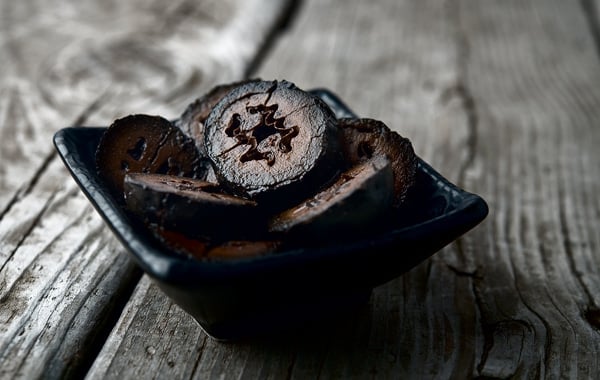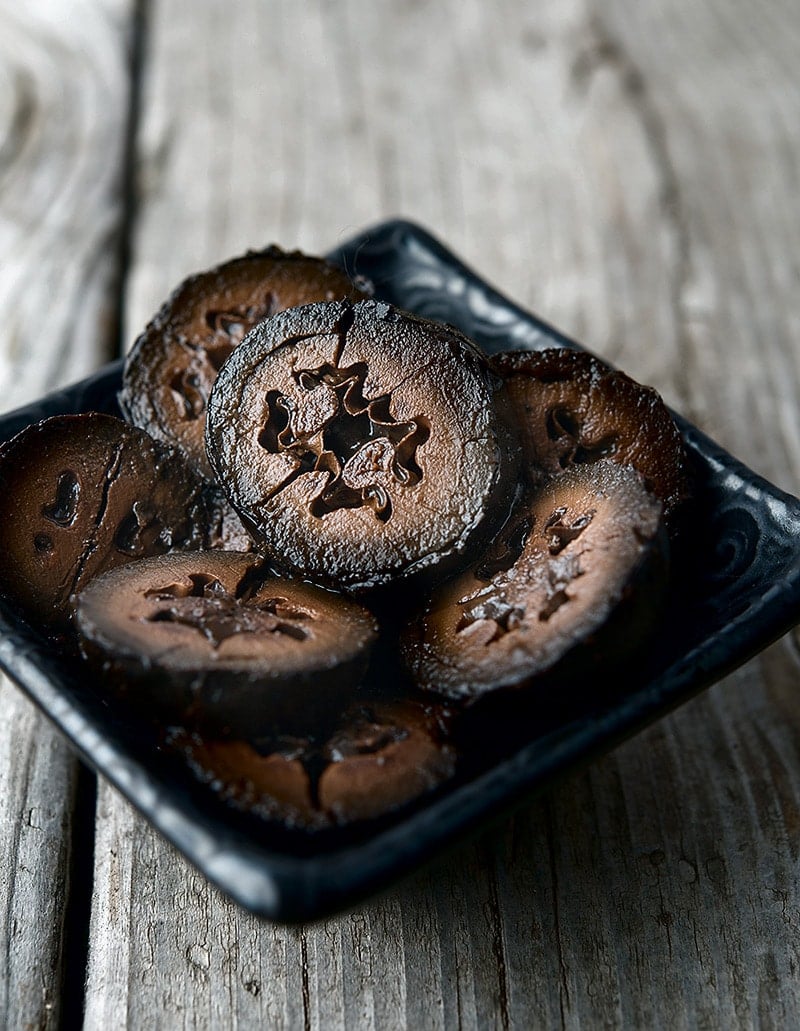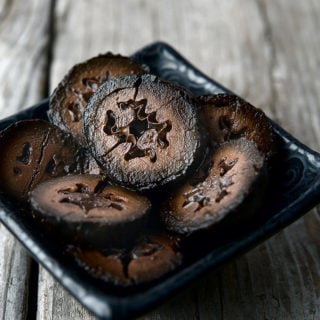As an Amazon Associate I earn from qualifying purchases.

There may be a few foods that are more English than pickled walnuts, but with the possible exception of fish and chips, I can’t think of one. Chances are, however, you’ve never heard of them. I hadn’t, until several years ago when I ordered the meat-and-cheese plate at a local Irish place called deVere’s.
On this place was a black disk. I asked the waitress what on earth it was, and she smiled; she’d had this question before: “It’s a pickled walnut. It’s good with the cheddar.”
I followed her advice and stabbed the disk with my fork, adding a bit of cheddar cheese and a bit of cold roast beef to round things out. Wow. It was a bit like eating solid steak sauce, with a little floral aroma and a zephyr of bitterness that just barely let you notice it.
I ate another disk all by itself: Fairly soft, puckery and strangely floral. And yes, there was definitely a Worcestershire-Heinz 57-A1-thing going on here. How had I never had these before?
Turns out that very, very few people outside of Britain eat them. This should change, which is why I am presenting you with this recipe. And the reason I am posting this now is because you need to get out and get your walnuts now. That’s right, you need green, unripe walnuts to make pickles. And yes, you use the whole thing, hull and all.

I got mine a few weeks ago, after an unsuccessful fishing trip with my friend Joe. We were in the Delta and as we were driving out, I noticed a NorCal black walnut (Juglans hindsii) absolutely laden down with nuts. “Pull over!” Joe, used to this by now, did. I gathered about 150 nuts in less than 15 minutes. It was a bonanza.
I knew I was in business right when I got to the tree, but just to be sure I pulled out my pocketknife and sliced an unripe nut in half. You need to do this, either with a knife or a stout needle or a long nail, because you have to catch the unripe walnuts before the shell forms. Once that shell forms inside the walnut’s hull, you’re too late; the traditional harvest date in England is late June.
The process for pickled walnuts is not hard at all, but it takes more than a week. You need to brine the green walnuts for a good long time before they will be ready to pickle properly. The brine time helps with preservation and removes some of the bitterness in the unripe walnuts. Once brine pickled, they are pretty durable.
Do you need to sun-blacken the walnuts? No, but doing so gives you a nice, uniform look to them. Otherwise they will be olive green in some places, blotchy black in others.

Once you have your pickled walnuts, what do you do with them? Look to the English. Traditionally they are part of a ploughman’s lunch, with other pickles, cheese and cold meats. But I see them a lot tossed into beef or lamb stews (pot pies and pasties, too!) in wintertime, and in summertime I’ve seen them served in cool salads alongside tomatoes, and accompanying shellfish such as scallops or shrimp.
Pickled Walnuts
Ingredients
- About 50 to 60 green, unripe walnuts
- 1/2 cup kosher salt
- 1/2 gallon water
- 2 quarts cider or malt vinegar
- 1 tablespoon cracked black pepper
- 1 tablespoon cracked allspice berries
- 1 ounce ginger, about 1 1/2-inch pieces, smashed
- 1 cup brown sugar
Instructions
- Dissolve the salt in the water to make a brine. Put on some rubber gloves if you have them, because walnut juice will stain your hands for weeks -- and it won't come off. Trust me on this one. Properly gloved, stab each walnut with a fork in several places; this helps the brine penetrate. Submerge the walnuts in the brine and let them ferment for 8 days at room temperature.
- Remove the walnuts and put them on a baking sheet and leave them outside in the sun for a day, until they turn uniformly black. You can do this step without gloves if you want.
- Pack the walnuts into quart jars. Bring the remaining ingredients to a boil and pour over the walnuts. Leave very little headspace in the jars. Seal and keep in a cool place, either the fridge or a basement -- you just want them to rest below 70°F -- for at least a month before you eat them. Kept this way they will last a year.
Notes
Nutrition
Nutrition information is automatically calculated, so should only be used as an approximation.






Hi. just found your site and I love it! Some of your recipes remind me of my mom’s and your pickled walnuts is one of them. She is long gone now but oh how I remember her pickled walnuts.
I had the good fortune to visit a farm some months ago that had made them so I bought 4 jars. Tried one the other day, but unfortunately it was rock hard… they were made months ago, in season. The lady is now trouble shooting to see what went wrong. Would you have any ideas?
I’m into pickled walnuts. love them. I have even ”invented?” (probably been done before) a device that makes the pricking real easy. The comment about the walnut dye is a fantastic idea, to late for me this year but will save the brine next year and do this. . Thanks for that.
I don’t think you can call it fermenting when you add vinegar beforehand. This is more like a quick pickle recipe. I’d be interested in how a traditionally fermented walnut tasted
Hi Hank, thanks for the recipe, I’m trying my first batch of pickled walnuts now and am looking forward to the results. As someone who hates to waste anything, I decided to experiment with using the brine solution as a dye instead of throwing away. It has produced amazing results, a beautiful dark brown with a slightly golden hue. I’ve washed once and the colour has stayed true. I’m assuming the salt is acting as a fixative, although I have read that walnut dye doesn’t need a mordant.
this is an awesome article, I’m so thankful to have found it & the comments! Question: to save space could you slice after brining & can them sliced or is that not advisable?
Ashley: Yes, you can, but they run the risk of getting mushy. It doesn’t always happen, but sometimes they get too soft when sliced that way.
Awesome…Thank you Hank!
Thank you for clearing that up Hank.
Should I have boiled the salt brine first before soaking the walnuts? I ask because if I should’ve then I think I still have time to harvest some green walnuts.
Mike: You’re fine. You just need the salt dissolved.
Hi Hank!
Help clear things up for me please. So an I to boil the salt water brine then pour this over the green walnuts? I didn’t do this. I made a double batch and just let the salt devolve into the water. Will this be OK? Also, am I supposed to add the vinegar and spices to the salt brine and pickle the walnuts in this solution or throw out the salt brine and only brine using the vinegar and spice brine?
Thank you for clearing this up for me.
Michael: You toss the brine.
hi, any reason you can’t just slice them in two and pickle the halves?
thx,
terry engel
Terry: Not that I know of.
Hi,
first of all I’d like to thank you for the recipe! I found your blog a year ago when I was making my first pickled walnuts ever (but didn’t know how they’re going to turn out so never commented). This year I’m doing my second batch (they’re fermenting as I write this) and so I’m back again. But this time I have a few questions. If you would be so kind as to advice me I’d really appreciate it.
I usually do somewhere from 4-6 jars at a time. In my experience some of them turn black during this process and some don’t and stay green (I have my lids on). Last year I didn’t sun dry them as you recommend. I kept both the green and the black jars and as it turned out the black ones were great but the green ones were hard and pretty much raw as to the taste, not really edible. Is this how they are when they ferment just require the air/sun exposure?
And my second question concerns the vinegar solution. I didn’t use the brine, just the vinegar. It was ok though very strong. I can’t figure out whether to include the brine as well as I can’t tell from the description whether or not to do that. Would I mix all the brine with the vinegar, then boil it and then use whatever amount required?
Thanks,
Daniel
Daniel: You can add some of the brine to the final mix.
I recently made 2 batches of these from the same walnuts/same time. The brine of the ones I had in a bucket turned black. The walnuts I had in brine in a glass jar look the same as when I put them in. What could be the reason for this? Thanks!
Hanna: Oxygen. They turn black on contact with air.
Hi, I have a walnut tree that every year self-thins its tiny walnuts (the size of capers). This year there seem to be a lot of them so I was wondering if you know if and how to pickle these tiny walnuts. Would you prick each one? Brine them? Sun dry them? Let me know what think. Thanks
Hi, me again.
You sure? At first I was doubtfull because usually you don´t find pickle recipes that call only for vinegar, usually they dilute it with an equal part of water, more or less, and that´s why I asked you. But then I thought it could be too salty or the total liquid would be too much for the walnuts, and then I found other recipes that only use vinegar, sugar and spices for the final pickling process.
Right now my walnuts are sun bathing and getting a nice dark color.
Hi Susan,
Yes, it was around 12th December, probably a couple of weeks late as a small number of them had shell forming, but this in no way overshadows their deliciousness. You just peel the flesh off around the shelly bits.
Next year I will harvest late November (Southern hemi). I would suspect you would pick earlier in Sydney (lower latitude)…what do you think Hank?
Hi Hank,
When you say bring the remaining ingredients to a boil, is just the vinegar and the spices, or the brine too? And you pour it hot on the walnuts?
I tried doing this last year but it was too late.
I am like 200 miles straight south from Laredo, so maybe they develop earlier due to the warmer weather.
Today I picked 60 black (or Mexican, maybe) walnuts, about 1.5 inches in diameter, from a tree that is precocious, the other trees’ walnuts are just about 0.5 inches right now.
Gonna check for size and shell hardness in May and June, to find out the best time for harvest.
Can hardly wait for your book in Sept.
Ricardo: Yes, the brine, too. And Given how far south you are, I’d start checking soon. You are about 800 miles south of me in Sacramento, CA.
Chris & Margaret from Tassie,
I’m in Sydney and was just wondering when you picked the green walnuts? I’m assuming end November or early December??
As the English say: “Brilliant.” Since you can’t come by and hunt them for me in the city limits this is one of the few ways I can beat the squirrels to the walnuts!
Oh yeah, I forgot to mention in my last post: The pickling does something wonderful to these tree nuts. It makes them edible to kids with allergies — at least mine. My daughter has tree nut allergies, and has a very sensitive palette. Her tongue goes “spicy” when any trace of a tree nut hits it. No matter how delicious the cookie, she ditches it and goes for water, but she can down pickled walnuts like crazy : )
Great post. It’s exciting to see so many people trying this old, familiar recipe. I grew up (in Canada) with these pickled walnuts, but the no sugar kind. So, to Silvia: yes, feel free to skip the sugar. Cracked black pepper, allspice and ginger are the only spices necessary for a blend that will make you pucker — particularly great with cheese and crackers. Adding sugar, cloves and other extras makes the walnuts nicer for meats — more of a complex flavour. I’ve made them too late and you’ll get a layer of goodness, and then an inedible skin that you have to pick out, and then a great centre. That wasn’t a great year of picking; we harvested them too late! This year many of ours turned out too woody, and they are a bit woody throughout, not a picking-too-late-shell-formed problem. I have theories about why that I’ll test upon next pickling session. These latest “firmer” ones are good for different recipes. Also, I keep pickled walnuts for way longer than a year and I often use white vinegar because of my budget and big batches — and that’s just the way we’ve done it in my family.
This is Chris from Tassie again.
I left the walnuts in brine in the (warm) shed for one week, then refreshed the brine and put in a 17 degree (celcius) room for two weeks (I was on vacation). On my return, I put them in the scorching hot Australian sun for two days, they went black as night. I pickled them according to Hank’s recipe and they are truly amazing. Thanks for the recipe and procedure Hank.
I highly recommend this to anyone. I now have 20 jars of pickled walnuts and they go amazingly well with crackers, cheese and smoked mussels.